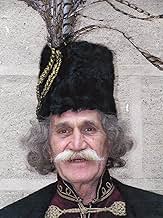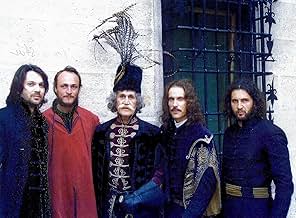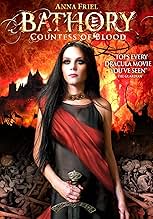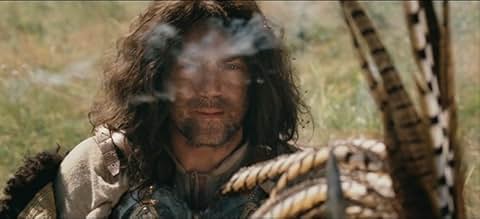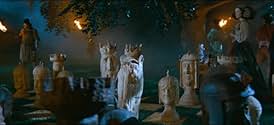NOTE IMDb
5,7/10
4,8 k
MA NOTE
Ajouter une intrigue dans votre langueWith an unquenchable thirst for blood, Countess Elizabeth Bathory was one of the most prolific serial killers in history.With an unquenchable thirst for blood, Countess Elizabeth Bathory was one of the most prolific serial killers in history.With an unquenchable thirst for blood, Countess Elizabeth Bathory was one of the most prolific serial killers in history.
- Réalisation
- Scénario
- Casting principal
- Récompenses
- 5 victoires et 4 nominations au total
Deana Horváthová
- Darvulia
- (as Deana Jakubisková-Horváthová)
Jaromír Nosek
- Miklós Zrínyi
- (as Míra Nosek)
Avis à la une
Well first off, I have to say that this is a very difficult movie to follow. Too many characters, and too much stuff going on. I honestly can't tell you everything that happens in this movie, because there is a ton.
This movie did not need to be 2 hours long. It could have been shorter than its original run time. The movie is divided into three segments; First segment, where we learn about the painter, and our characters, is the most interesting best segment in the movie.
The second segment and third segments are about the witch and the king fighting with them. Erzsébet Bathory over land? (I think) which did not need to be long as it was. I can tell you that the Turk fighting scenes look amazing, and the movie is for the most part well shot. However, the story drags, it does get kinda dull after 1 hour passed. I was engaged and enjoyed the movie after the second hour started it just lost its sting for me it did. There are some beautifully shot scenes in this movie too, like the blood bath, and the blue flowers, which look incredible.
I can't see myself watching this thing again, but it was kinda fun. Also if you expect Gore in this, there's barely any gore in this at all, even the little bit of gore we see is incredibly tame.
There are films like the Girl with a Dragon Tattoo and Eyes of My Mother that are kinda tame in the start, but then snap you in the end. This movie was fun in the start but gets dull afterward.
This movie did not need to be 2 hours long. It could have been shorter than its original run time. The movie is divided into three segments; First segment, where we learn about the painter, and our characters, is the most interesting best segment in the movie.
The second segment and third segments are about the witch and the king fighting with them. Erzsébet Bathory over land? (I think) which did not need to be long as it was. I can tell you that the Turk fighting scenes look amazing, and the movie is for the most part well shot. However, the story drags, it does get kinda dull after 1 hour passed. I was engaged and enjoyed the movie after the second hour started it just lost its sting for me it did. There are some beautifully shot scenes in this movie too, like the blood bath, and the blue flowers, which look incredible.
I can't see myself watching this thing again, but it was kinda fun. Also if you expect Gore in this, there's barely any gore in this at all, even the little bit of gore we see is incredibly tame.
There are films like the Girl with a Dragon Tattoo and Eyes of My Mother that are kinda tame in the start, but then snap you in the end. This movie was fun in the start but gets dull afterward.
Lavish, romanticized account of the life and times of 16th century Hungarian countess Erzsébet Bathory, history's most prolific serial killer...
BATHORY, a would-be epic with nice period detail, aspires to myth-buster status by painting the "Bloody Countess of Čachtice" as a victim of political chicanery in a male-dominated society but all it accomplishes is a "legend" of its own by white-washing history, facts be damned. Here, as a wealthy woman who's vast holdings could turn the tide in a power struggle between Catholics and Protestants as they fight off a Muslim invasion, Countess Bathory is more sinned against than sinning and framed for crimes she never committed. Yeah, right. Valentine Penrose & Alexander Trocchi's well-researched "The Bloody Countess: Atrocities Of Erzsébet Bathory", offers a significantly different account based on historical records:
"Descended from one of the most ancient aristocratic families of Europe, Erzsébet Bathory bore the psychotic aberrations of centuries of intermarriage. From adolescence she indulged in sadistic lesbian fantasies where only the spilling of a woman's blood could satisfy her urges. By middle age she had regressed to a mirror-fixated state of pathological necro-sadism involving witchcraft, torture, blood-drinking, cannibalism and, inevitably, wholesale slaughter. These years, at the latter end of the 16th century, witnessed a reign of cruelty unsurpassed in the annals of mass murder with the Countess' depredations on the virgin girls of the Carpathians leading to some 650 deaths. Her many castles were equipped with chambers where she would hideously torture and mutilate her victims, becoming a murder factory where hundreds of girls were killed and processed for the ultimate youth-giving ritual: the bath of blood..."
In Juraj Jakubisko's film, Erzsébet Bathory is depicted as an intelligent woman ahead of her time and a Protestant preyed upon by the Catholic Church as well as her late husband's covetous best friend although she still finds time for a passionate affair with the Italian painter Caravaggio (!) as her subjects try inventing spring-powered roller skates, phonographs, still photography, and primitive airplanes a la Leonardo Da Vinci. The tale, a de-fanged poison valentine to renaissance Hungary, is served up on a grand scale but twists the truth into a monumental mis-carriage of injustice that's recommended to revisionists only. What's next, JEFFREY DAHMER -THE MUSICAL?
BATHORY, a would-be epic with nice period detail, aspires to myth-buster status by painting the "Bloody Countess of Čachtice" as a victim of political chicanery in a male-dominated society but all it accomplishes is a "legend" of its own by white-washing history, facts be damned. Here, as a wealthy woman who's vast holdings could turn the tide in a power struggle between Catholics and Protestants as they fight off a Muslim invasion, Countess Bathory is more sinned against than sinning and framed for crimes she never committed. Yeah, right. Valentine Penrose & Alexander Trocchi's well-researched "The Bloody Countess: Atrocities Of Erzsébet Bathory", offers a significantly different account based on historical records:
"Descended from one of the most ancient aristocratic families of Europe, Erzsébet Bathory bore the psychotic aberrations of centuries of intermarriage. From adolescence she indulged in sadistic lesbian fantasies where only the spilling of a woman's blood could satisfy her urges. By middle age she had regressed to a mirror-fixated state of pathological necro-sadism involving witchcraft, torture, blood-drinking, cannibalism and, inevitably, wholesale slaughter. These years, at the latter end of the 16th century, witnessed a reign of cruelty unsurpassed in the annals of mass murder with the Countess' depredations on the virgin girls of the Carpathians leading to some 650 deaths. Her many castles were equipped with chambers where she would hideously torture and mutilate her victims, becoming a murder factory where hundreds of girls were killed and processed for the ultimate youth-giving ritual: the bath of blood..."
In Juraj Jakubisko's film, Erzsébet Bathory is depicted as an intelligent woman ahead of her time and a Protestant preyed upon by the Catholic Church as well as her late husband's covetous best friend although she still finds time for a passionate affair with the Italian painter Caravaggio (!) as her subjects try inventing spring-powered roller skates, phonographs, still photography, and primitive airplanes a la Leonardo Da Vinci. The tale, a de-fanged poison valentine to renaissance Hungary, is served up on a grand scale but twists the truth into a monumental mis-carriage of injustice that's recommended to revisionists only. What's next, JEFFREY DAHMER -THE MUSICAL?
1. The dialogue writing and delivery are absolute cringe-worthy the entire duration of the film.
2. The film has a glaring anachronism in every scene.
3. I am not myself obsessed with plot holes, but when there are so many and they are so obvious it makes a viewer certain the writers assume their audience is mentally challenged.
Many reviews here find the monks' humor out of place, inappropriate, or they just didn't see the purpose of it. It's my opinion that if you didn't find it amusing, then its most likely more of a cultural difference than a matter of taste. This type of humor is very common in Slovakia and Romania. I'm saying this as a Slovak-American, someone married to a Romanian, and who lived in Romania for five years.
I also agree with the reviewers who point out this is a post-modernist historical fiction. It's more of a fantasy than either a horror tale or historical biography.
Yes, there are some flaws with the point-of-view at the beginning. The first part was disjointed because it kept switching plot lines and character focus, but the second and third parts worked magically. I'm sure it also seemed complex or confusing if you are not familiar with the inner struggles and politics of the Hungarians, Slovaks, and Romanians at that time. But, I find it interesting and even amusing that the conflicts still continue within these reviews about whose version of history is right (or best) -- the Hungarian Catholics, the Lutherans, the Slovaks, the Romanians in Transylvania, etc. That's basically the point of the movie! We'll never know the "truth" unless we could have had some spies there writing it all down in a record that also verified the other evidence. Every noble family and religion in that space has always had political power motives in presenting their own versions of history. It gets so crazy and sad at a point that all you can do is make a joke (like the monks) and try to laugh so you don't go crazy too.
I also agree with the reviewers who point out this is a post-modernist historical fiction. It's more of a fantasy than either a horror tale or historical biography.
Yes, there are some flaws with the point-of-view at the beginning. The first part was disjointed because it kept switching plot lines and character focus, but the second and third parts worked magically. I'm sure it also seemed complex or confusing if you are not familiar with the inner struggles and politics of the Hungarians, Slovaks, and Romanians at that time. But, I find it interesting and even amusing that the conflicts still continue within these reviews about whose version of history is right (or best) -- the Hungarian Catholics, the Lutherans, the Slovaks, the Romanians in Transylvania, etc. That's basically the point of the movie! We'll never know the "truth" unless we could have had some spies there writing it all down in a record that also verified the other evidence. Every noble family and religion in that space has always had political power motives in presenting their own versions of history. It gets so crazy and sad at a point that all you can do is make a joke (like the monks) and try to laugh so you don't go crazy too.
Fields stained with Turkish blood. Villages and witches burned. High castles and deep catacombs. Bleak life full of vivid imagination. Such is the world Bathory, The Bloody Lady of Cachtice.
Elizabeth Bathory lets you see the film through the eyes of a mother, lover and ruler rather than the legendary serial killer. Throughout the film she strives to protect her children, love and land while ignoring her tainted reputation. The intrigues escalate. Blood is spilled. And a false myth is born.
Although there is a complex epic plot, the film feels more like a series of still pictures. There is a lot of symbolism and the plot slows down so that you can fully enjoy it. Apart from the story, the Bathory also takes some time to explain how myths are created and abused to serve one’s needs. The acting is outstanding but does not stand out as much as the Hungarian costumes that make the film look fresh.
Unfortunately the movie is significantly flawed by repetitive comic relief in which two monks use various inventions to spy on the countess. They seem to have come from another movie and make you question the taste of the writers. Should there be a version without those comedians a 9/10 rating would be appropriate.
Elizabeth Bathory lets you see the film through the eyes of a mother, lover and ruler rather than the legendary serial killer. Throughout the film she strives to protect her children, love and land while ignoring her tainted reputation. The intrigues escalate. Blood is spilled. And a false myth is born.
Although there is a complex epic plot, the film feels more like a series of still pictures. There is a lot of symbolism and the plot slows down so that you can fully enjoy it. Apart from the story, the Bathory also takes some time to explain how myths are created and abused to serve one’s needs. The acting is outstanding but does not stand out as much as the Hungarian costumes that make the film look fresh.
Unfortunately the movie is significantly flawed by repetitive comic relief in which two monks use various inventions to spy on the countess. They seem to have come from another movie and make you question the taste of the writers. Should there be a version without those comedians a 9/10 rating would be appropriate.
Le saviez-vous
- AnecdotesFamke Janssen was originally signed on for the part of Bathory, but for reasons unknown she backed out. Anna Friel read the script and fell in love with it and sent the director a letter convincing him to cast her. It was written in Slovak language, because her babysitter was from Slovakia and helped her writing it.
- ConnexionsReferenced in Vsechnopárty: Épisode datant du 24 juin 2008 (2008)
Meilleurs choix
Connectez-vous pour évaluer et suivre la liste de favoris afin de recevoir des recommandations personnalisées
- How long is Bathory: Countess of Blood?Alimenté par Alexa
Détails
- Date de sortie
- Pays d’origine
- Langue
- Aussi connu sous le nom de
- Chroniques d'Erzebeth
- Lieux de tournage
- Sociétés de production
- Voir plus de crédits d'entreprise sur IMDbPro
Box-office
- Montant brut mondial
- 7 005 528 $US
- Durée2 heures 21 minutes
- Couleur
- Mixage
- Rapport de forme
- 2.35 : 1
Contribuer à cette page
Suggérer une modification ou ajouter du contenu manquant

Lacune principale
By what name was Chroniques d'Erzebeth: Le Royaume Assailli (2008) officially released in India in English?
Répondre


